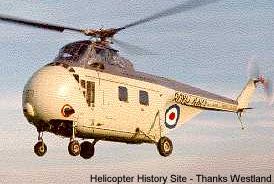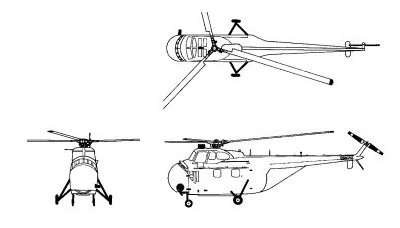
During 1950, the Royal Navy had received 10 rescue (HAR.21) and 15 anti-submarine (HAS.22) versions of the Sikorsky-built S-55 airframes for evaluation. Westland announced negotiations with Sikorsky in Nov 1950 to produce the S-55 under licence for British forces. By 1953 the agreement had extended to modifying the basic airframe and marketing the model as well. 
The main driver for the S-55 evaluation was the frustration of the Admiralty over the difficulties experienced in development and sea tests by the Bristol Type 191 (a navalised and uprated Type 173) and its engines. Westland Helicopters was asked whether modifications to the S-55 would allow it to carry a sonar or an anti-submarine weapon, or both. 
Westland had acquired some familiarity with the US built Sikorsky S-55. In November 1950, it negotiated a licence from Sikorsky to build and develop the type in the UK, leading eventually to fully anglicised versions. In the meantime, S-55s assembled in the UK entered service from 1952. 
The first British Whirlwind flew at Yeovil on 15 Aug 1953 for the Royal Navy with a 3 man crew and three more versions of the Series 1, two for the RAF as transport and rescue missions in 1955 and an improved search and rescue version for the Navy in 1953. All of these were powered by Pratt & Whitney Wasp and later, Wright Cyclone engines but with increasing amounts of British equipment. 
The Whirlwind HAR.5 (a prototype development of the naval HAR.3) was the first British engined version, to be powered by the 14 cylinder, 882hp, double radial Alvis Leonides Major derated to deliver 750hp in 1955. It introduced a downward drooping tail cone, to improve clearance from the main rotor assembly but never entered production and was quickly followed by the HAS.7 - the first helicopter to be specifically developed for the anti-submarine role in 1956. 
Westland judged that turbine engines were powerful and reliable enough to incorporate the Gnome into the HAR.9, which needed a redesigned nose section to accomodate the larger engine in a position to make maintenance more convenient. The first Series 3 (a HAR.9) flew in Feb 1959 and was also the basis of the dedicated RAF Search and Rescue HAR.10 and HCC.10 VIP conversion. 
A number of versions were built for civil commercial passenger and freight users, both for the UK and export market. More than 400 Whirlwinds were built in total and around 100 were exported to Austria, Brazil, Canada, Cuba, France, Ghana, Jordan, Iran, Kuwait, Spain, Saudi Arabia and Yugoslavia - either as new build machines or after retirement from military service. 
Specifications Whirlwind |
Derivatives & Versions of Whirlwind |
| Model | Year | History |
|---|---|---|
| Whirlwind HAR.1 1952 | 1952 | Initial Whirlwind for Royal Navy with Pratt & Whitney Wasp R-1340-40 engines. used for search and rescue, 10 built. |
| Whirlwind SRS.1 1953 | 1953 | Initial civil Whirlwind with American engines (Pratt & Whitney Wasp R-1340-40), 44 built. |
| Whirlwind HAR.3 1954 | 1954 | Westland WS-55 Whirlwind utility transport for Royal Navy powered by Wright Cyclone engine, 25 built. |
| Whirlwind HAR.4 1954 | 1954 | Improved HAR.2 for hot and high conditions, 24 built for RAF. Many survivors converted to HAR.10. |
| Whirlwind HAR.2 1955 | 1955 | Westland WS-55 Whirlwind utility transport for Royal Air Force powered by Wright Cyclone engine, 33 built. |
| Whirlwind HAR.5 1955 | 1955 | Westland WS-55 Whirlwind for Royal Navy powered by Alvis Leonides Major engine and a 3 degree droop of the tail boom for increased main rotor cle ... |
| Whirlwind HAS.7 1956 | 1956 | Westland WS-55 Whirlwind powered by Alvis Leonides Major engine and a 3 degree droop of the tail boom for increased main rotor clearance. 120 bui ... Early individuals of the HAS.7 were plagued by engine problems, principally with the centrifugal clutch mechanism of the Alvis Leonides Major Mk. ... |
| Whirlwind HCC.8 1956 | 1956 | VIP version powered by Alvis Leonides engine, 2 built for UK Royal Flight. |
| Whirlwind SRS.2 1956 | 1956 | Westland WS-55 Whirlwind with Alvis Leonides Major 755 engine for civilian use, 19 built. |
| Whirlwind HAR.9 1957 | 1957 | Westland judged that turbine engines were powerful and reliable enough to incorporate the Rolls Royce Gnome engine into the Whirlwind Srs.3. Thi ... Converted HAS.7 powered by Bristol Siddeley Gnome engine and outifitted for SAR for Royal Navy, 15 conversions of HAS.7. [One source stated 18 co ... |
| Whirlwind HAR.10 1959 | 1959 | Improved SAR/transport version powered by Bristol Siddeley Gnome engine, 68 new built for Royal Air Force, plus many conversion from earlier mark ... |
| Whirlwind SRS.3 1959 | 1959 | Civil conversion of Whirlwind Ser. 1&2 and new build with Gnome turbine engine. |
| 1961 | 1961 | Soko initially assembled locally two versions of Westland Whirlwind (HAR.5 & HAS.7) for the Yugoslav Air Force and Navy respectively before comme ... |
| Whirlwind HCC.12 1964 | 1964 | Improved VIP version powered by Bristol Siddeley Gnome engine, 2 built for UK Royal Flight. |
| Whirlwind HAS.3B 1965 | 1965 | Westland WS-55 Whirlwind ASW export model for Brazilian Navy powered by Gnome engine, ? built. |

